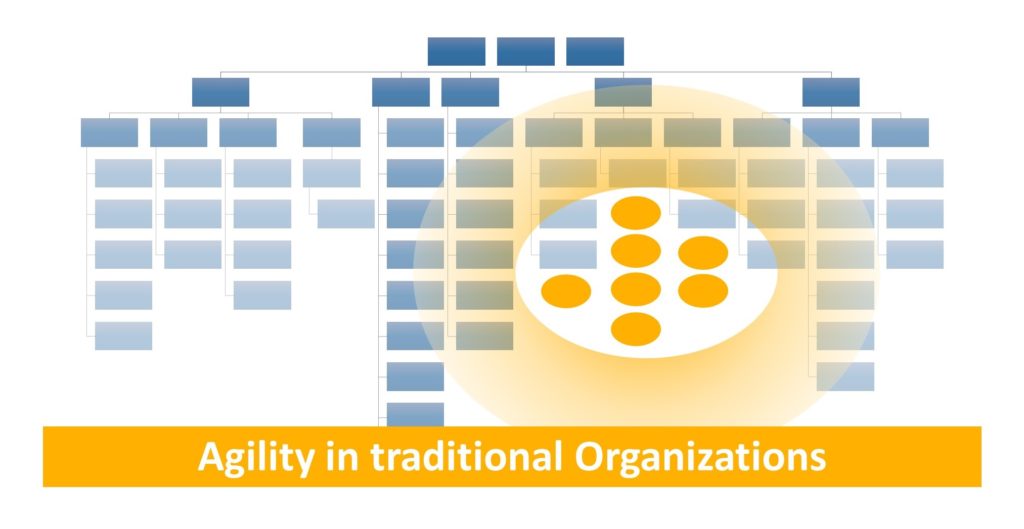Recently I had a conversation with a very experienced Agile Coach. After some time, we ended up with a topic that I had already discussed several times with experts.
It was about whether problems with agile working in larger hierarchical organizations always must be answered with “more agility”, whether more agile expertise is still the best solution for a hybrid organizational situation. In each case, the thesis was that “an established hierarchy has to become agile quickly in case of difficulties in working with agile teams. After all, this is much better. Then the problem is solved. “
Imagine a large company with a traditional hierarchical structure for essential parts of the organization. And at the same time, there is an organizational unit there that is agile. This is a common scenario in large companies because the IT departments have often been working with agile methods for many years, while agility in the rest of the organization is often only partially supported at the same time.

In such a situation, if a project team is made up of agile and traditional units, sooner or later, tensions can arise between the project participants.
For example, some want predictable planning, and others wish to an iterative approach in short planning cycles. This situation occurs frequently. There are even well-known terms for it, such as “hybrid organization“, “hybrid projects” and “agile project management“.
Now, in the conversations with Agile Coaches mentioned at the beginning, I sometimes hear the demand for “more agility” from the traditionally led teams for these situations. Because from agile teams, agility is often “the better process model and the hierarchically structured groups should finally overcome themselves to adopt the better. Then cooperation would no longer be a problem. ” This can be a solution, if the hierarchically managed teams are willing to do so and if they can deal with the associated effects, the different way of working, in their structures.
For example, a representative from a classically structured line structure can create the required management tools of “his world” for himself. Still, the agile team would not want to support them or only to a limited extent. This is because the team, in turn, works according to a different principle, i.e. after working through a continually changing backlog in very short cycles. A reliable estimate of completion time for specific content is therefore not possible, because the material can improve regularly. It is therefore not a matter of planning time, costs and effort, but of effectively processing customer requirements according to their priorities. And this is done until the customer does not want any more needs to be implemented. These two approaches are difficult to standardize on a pure process level.
Another, very different principle is the kind of leadership that an agile self-organized team expects.
Such a team is used to being able and expected to organise itself within the agreed framework. This, in turn, requires a leadership behaviour of line and project managers that provides freedom for these teams and has confidence in their work.
However, a manager from classically managed structures would quickly find himself responsible for keeping an overview and control and could therefore regularly demand details from the teams to have more insight and be able to make decisions himself. This contradicts the principle of self-organization and can, thus quickly lead to tension.
Whenever such or similar tensions arise between these two worlds, proposals for solutions from the two camps are immediately served up. A traditional manager might ask for more control through more reporting at shorter intervals or more centralized decision making on project management or even the steering committee. These are all established management approaches that have worked well in this environment for decades and continue to do so today. Unfortunately, these do not fit the principles of agile working.
And this is perhaps where the proposal comes from the agile organization, which calls on the traditional part of the company to join the agile way of working. Sometimes this demand is also formulated very clearly and directly because the agile organization might see this as the best solution.
Many agile experts think that “hybrid” collaboration (a little something from both worlds) cannot work well. This is because traditional and agile working does not fit together methodically. So, it is not optimal.
There are, therefore, three basic solution directions:
- All participants orientate themselves on the classically established management process
This is usually the requirement of a prestigious organization. This solution works if the agile teams are no longer nimble and use classic project management methods instead.
2. All participants orientate themselves to the new agile process
This is often the demand of representatives of an agile organization. This works if the participants adhere to agile processes and largely dispense with classic planning, controlling and steering mechanisms.
This is very close to the demand for a fundamental agilisation of the hierarchical parts of the organisation. If this is the strategic choice of top management anyway, the way is clear: Agility for the classic organization!
If it is not the chosen goal, it is likely that in a larger organization, this will not happen, or only to a minimal extent.
3. Establish hybrid cooperation (a ‘work hack’)
This describes a possibly significant compromise between the two worlds. An agreement is never perfect but allows elements of both worlds to be used or combined.
However, they should be consciously and purposefully linked together, and their positive and possible adverse effects should be considered.
This requires someone who can combine traditional and agile elements in a goal-oriented manner and who understands the impact this has on issues such as processes, roles, information distribution, decision making, leadership and control in both worlds.
(See also this article on “Agile project management, work hack for hybrid organizations“: https://www.coverdale.at/agiles-projektmanagement/ )
So, when you encounter the need for collaboration between agile and traditional parts of the organization in a large company, there are different solutions. That there is a preference for specific solutions depending on the parties involved is very understandable.
There should, however, be a conscious decision for existing options, based on a neutral point of view. Not because “agile” sounds more modern to many or because “traditional” has more powerful management.
From this point of view, my conversations with agile consultants are easy to classify. I got the opinion of representatives of the agile camp, the Agile Coach. So, the solution was “Agility for all” because it is the seemingly better option for the agile consultant. From “A” the answer “A” often seems to be the right one!
Complex and highly cross-cutting organisational development issues require a broad perspective to see options and be able to view them from a neutral perspective.


Recent Comments